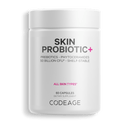- Codeage Skin Probiotic+ contains a potent blend of probiotics and prebiotics with 50 billion CFUs* per serving.
- Formulated with a selection of botanical herbs like camu camu powder, Triphala extract, holy basil extract, fenugreek extract, asparagus, mangosteen powder, açaí powder, ginger extract, and rose hips extract.
- Codeage Skin Probiotic+ is further enriched with vitamin C sourced from acerola cherry, which is carefully selected to complement the overall formulation. This addition brings a refreshing element to your daily skincare routine.
- This skin probiotic formula also includes phytoceramides, naturally occurring lipids found in the skin.
- Codeage Skin Probiotics is non-GMO, soy-free, dairy-free, and gluten-free. It is manufactured in a cGMP-certified facility in the USA with global ingredients for purity and quality. This formula contains no egg, wheat, shellfish, additives, or preservatives. It is suitable for men and women and is shelf-stable with no refrigeration needed.
Skin Probiotic+
Codeage Skin Probiotic+ supplement offers probiotics, prebiotics, vitamin C, phytoceramides, and an advanced selection of herbs and fruits. This skincare formula is designed for women and men.
- Codeage Skin Probiotic+ contains a potent blend of probiotics and prebiotics with 50 billion CFUs* per serving.
- Formulated with a selection of botanical herbs like camu camu powder, Triphala extract, holy basil extract, fenugreek extract, asparagus, mangosteen powder, açaí powder, ginger extract, and rose hips extract.
- Codeage Skin Probiotic+ is further enriched with vitamin C sourced from acerola cherry, which is carefully selected to complement the overall formulation. This addition brings a refreshing element to your daily skincare routine.
- This skin probiotic formula also includes phytoceramides, naturally occurring lipids found in the skin.
- Codeage Skin Probiotics is non-GMO, soy-free, dairy-free, and gluten-free. It is manufactured in a cGMP-certified facility in the USA with global ingredients for purity and quality. This formula contains no egg, wheat, shellfish, additives, or preservatives. It is suitable for men and women and is shelf-stable with no refrigeration needed.
Similar item to consider

SBO Probiotic + 50 Billion CFUs.
$34.99Codeage Skin Probiotic+ supplement offers probiotics, prebiotics, vitamin C, phytoceramides, and an advanced selection of herbs and fruits. This skincare formula is designed for women and men.
Supplement Facts

Ingredients
Vitamin C (from Acerola Cherry Extract), Proprietary Blend: Fermented Indian Frankincense Resin Extract (Boswellia serrata), Camu Camu Powder (Myrciaria dubia; Fruit), Fermented Triphala Extract (Amla Fruit Extract), Fermented Holy Basil Extract (Ocimum tenuiflorum; Leaf), Fermented Elecampane Extract (Root), Fermented Fenugreek Extract (Seed), Fermented Asparagus (Shoot), Mangosteen Powder (Garcinia mangostana; Fruit), Açaí Powder (Euterpe oleracea; Berry), Huang Qi Extract (Astragalus propinquus; Root), Ginger Extract (Root), White Peony Extract Root, Rose Hip Fruit Extract; Probiotic Blend (50 Billion CFU‡): S. boulardii, B. coagulans, L plantarum, L. paracasei, L. rhamnosus, L. casei, B. lactis, B. breve, B. bifidum, L. acidophilus, L. fermentum, L. gasseri, L. helveticus, B.longum, L. johnsonii, L. crispatus, L. bulgaricus, B. subtilis, B. clausii; Phytoceramides. Other Ingredients: Enteric Coating, Methylcellulose Capsule.
‡At time of manufacture.
Similar item to consider

SBO Probiotic + 50 Billion CFUs.
$34.99EXPLORE MORE.
PRODUCT GALLERY.





Product Details
Supplement Facts

Ingredients
Vitamin C (from Acerola Cherry Extract), Proprietary Blend: Fermented Indian Frankincense Resin Extract (Boswellia serrata), Camu Camu Powder (Myrciaria dubia; Fruit), Fermented Triphala Extract (Amla Fruit Extract), Fermented Holy Basil Extract (Ocimum tenuiflorum; Leaf), Fermented Elecampane Extract (Root), Fermented Fenugreek Extract (Seed), Fermented Asparagus (Shoot), Mangosteen Powder (Garcinia mangostana; Fruit), Açaí Powder (Euterpe oleracea; Berry), Huang Qi Extract (Astragalus propinquus; Root), Ginger Extract (Root), White Peony Extract Root, Rose Hip Fruit Extract; Probiotic Blend (50 Billion CFU‡): S. boulardii, B. coagulans, L plantarum, L. paracasei, L. rhamnosus, L. casei, B. lactis, B. breve, B. bifidum, L. acidophilus, L. fermentum, L. gasseri, L. helveticus, B.longum, L. johnsonii, L. crispatus, L. bulgaricus, B. subtilis, B. clausii; Phytoceramides. Other Ingredients: Enteric Coating, Methylcellulose Capsule.
‡At time of manufacture.
Suggested Use
Adults take two capsules daily with 8 ounces of water or your favorite beverage. May be taken with or without food.
CAUTION: Do not exceed recommended dose. Pregnant, nursing mothers, children under 18 and individuals with a known medical condition should consult a physician before using this or any dietary supplement. Please use caution if you have allergies or sensitivities to any of the listed ingredients. Keep out of reach of children and pets. Do not use if safety seal is damaged or missing. Store in a cool dry place. Use this product as a food supplement only. Do not use for weight reduction.EXPLORE MORE.

Gut and skin
wellness.
Codeage Skin Probiotic+ supplement offers a powerful blend of 50 billion CFUs of probiotics, prebiotics, vitamin C, phytoceramides, and botanical extracts designed for both women and men. This formula includes herbs like camu camu, Triphala, holy basil, fenugreek, mangosteen, and açaí, along with vitamin C and phytoceramides.
SUGGESTED USE.
Adults take two capsules daily with 8 ounces of water or your favorite beverage. May be taken with or without food.






































































